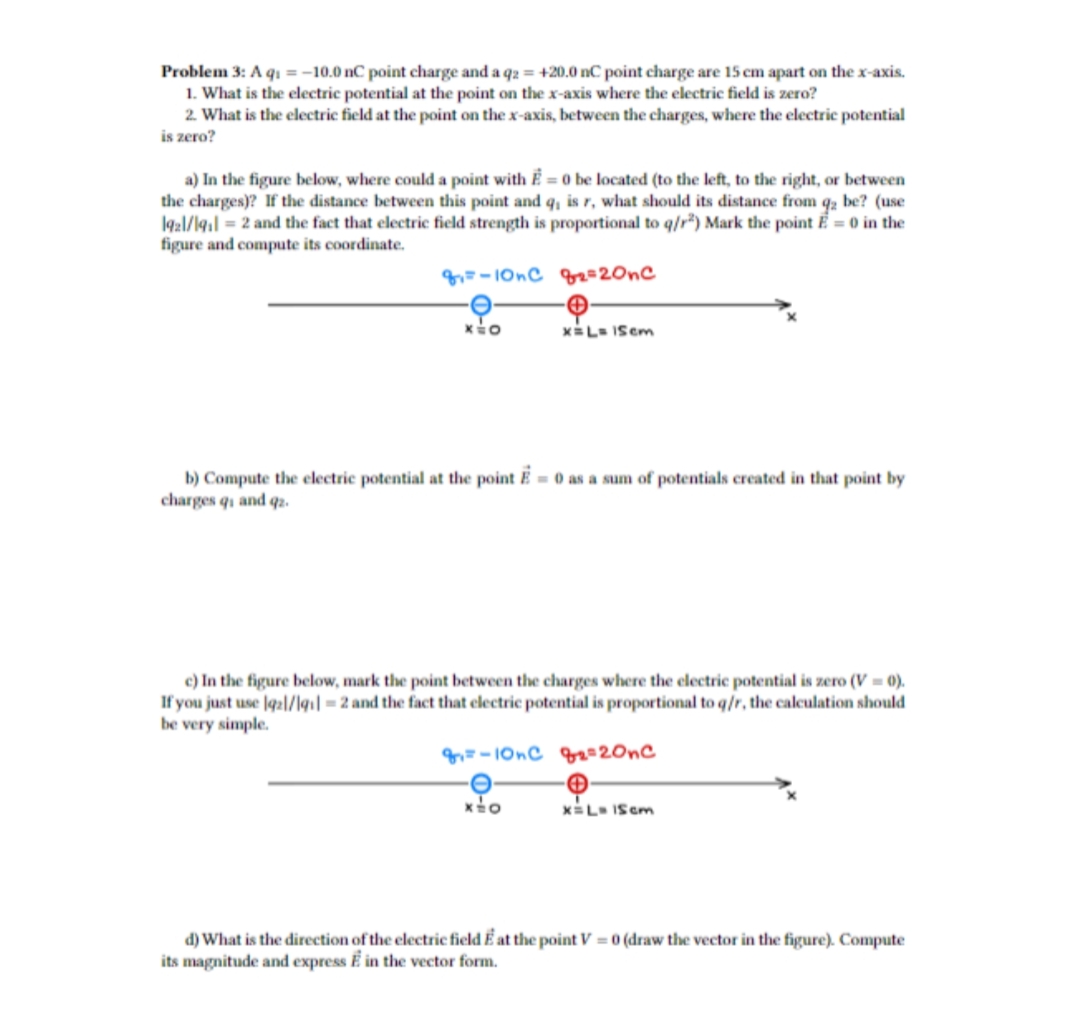Problem 3: A q₁ = -10.0 nC point charge and a q2 = +20.0 nC point charge are 15 cm apart on the x-axis. 1. What is the electric potential at the point on the x-axis where the electric field is zero? 2. What is the electric field at the point on the x-axis, between the charges, where the electric potential is zero? a) In the figure below, where could a point with E= 0 be located (to the left, to the right, or between the charges)? If the distance between this point and q, is r, what should its distance from q2 be? (use 1921/1911 = 2 and the fact that electric field strength is proportional to q/r2) Mark the point E= 0 in the figure and compute its coordinate. 8-10 nC g₂=20nc XEO b) Compute the electric potential at the point E = 0 as a sum of potentials created in that point by charges q, and q2. x=L= 15cm c) In the figure below, mark the point between the charges where the electric potential is zero (V = 0). If you just use 1921/1q11-2 and the fact that electric potential is proportional to q/r, the calculation should be very simple. g₁=-10nC oܪx g₂=20nc ✪ x=L= 15cm d) What is the direction of the electric field E at the point V = 0 (draw the vector in the figure). Compute its magnitude and express E in the vector form.
Problem 3: A q₁ = -10.0 nC point charge and a q2 = +20.0 nC point charge are 15 cm apart on the x-axis. 1. What is the electric potential at the point on the x-axis where the electric field is zero? 2. What is the electric field at the point on the x-axis, between the charges, where the electric potential is zero? a) In the figure below, where could a point with E= 0 be located (to the left, to the right, or between the charges)? If the distance between this point and q, is r, what should its distance from q2 be? (use 1921/1911 = 2 and the fact that electric field strength is proportional to q/r2) Mark the point E= 0 in the figure and compute its coordinate. 8-10 nC g₂=20nc XEO b) Compute the electric potential at the point E = 0 as a sum of potentials created in that point by charges q, and q2. x=L= 15cm c) In the figure below, mark the point between the charges where the electric potential is zero (V = 0). If you just use 1921/1q11-2 and the fact that electric potential is proportional to q/r, the calculation should be very simple. g₁=-10nC oܪx g₂=20nc ✪ x=L= 15cm d) What is the direction of the electric field E at the point V = 0 (draw the vector in the figure). Compute its magnitude and express E in the vector form.
College Physics
10th Edition
ISBN:9781285737027
Author:Raymond A. Serway, Chris Vuille
Publisher:Raymond A. Serway, Chris Vuille
Chapter16: Electrical Energy And Capacitance
Section: Chapter Questions
Problem 18P: A positive point charge q = +2.50 nC is located at x = 1.20 m and a negative charge of 2q = 5.00 nC...
Related questions
Question

Transcribed Image Text:Problem 3: A q₁ = -10.0 nC point charge and a q2 = +20.0 nC point charge are 15 cm apart on the x-axis.
1. What is the electric potential at the point on the x-axis where the electric field is zero?
2. What is the electric field at the point on the x-axis, between the charges, where the electric potential
is zero?
a) In the figure below, where could a point with = 0 be located (to the left, to the right, or between
the charges)? If the distance between this point and q, is r, what should its distance from qz be? (use
1921/1911 = 2 and the fact that electric field strength is proportional to q/r²) Mark the point = 0 in the
figure and compute its coordinate.
8₁=-10 nC
g₂=20nc
νέο
x=L= 15cm
b) Compute the electric potential at the point E = 0 as a sum of potentials created in that point by
charges q, and qz.
c) In the figure below, mark the point between the charges where the electric potential is zero (V = 0).
If you just use 1921/1q11-2 and the fact that electric potential is proportional to q/r, the calculation should
be very simple.
8₁=-10 nC g₂=20nC
✪
x=L= 15cm
X÷O
d) What is the direction of the electric field E at the point V = 0 (draw the vector in the figure). Compute
its magnitude and express E in the vector form.
Expert Solution
This question has been solved!
Explore an expertly crafted, step-by-step solution for a thorough understanding of key concepts.
Step by step
Solved in 2 steps with 2 images

Knowledge Booster
Learn more about
Need a deep-dive on the concept behind this application? Look no further. Learn more about this topic, physics and related others by exploring similar questions and additional content below.Recommended textbooks for you

College Physics
Physics
ISBN:
9781285737027
Author:
Raymond A. Serway, Chris Vuille
Publisher:
Cengage Learning

College Physics
Physics
ISBN:
9781305952300
Author:
Raymond A. Serway, Chris Vuille
Publisher:
Cengage Learning

Physics for Scientists and Engineers, Technology …
Physics
ISBN:
9781305116399
Author:
Raymond A. Serway, John W. Jewett
Publisher:
Cengage Learning

College Physics
Physics
ISBN:
9781285737027
Author:
Raymond A. Serway, Chris Vuille
Publisher:
Cengage Learning

College Physics
Physics
ISBN:
9781305952300
Author:
Raymond A. Serway, Chris Vuille
Publisher:
Cengage Learning

Physics for Scientists and Engineers, Technology …
Physics
ISBN:
9781305116399
Author:
Raymond A. Serway, John W. Jewett
Publisher:
Cengage Learning

Physics for Scientists and Engineers: Foundations…
Physics
ISBN:
9781133939146
Author:
Katz, Debora M.
Publisher:
Cengage Learning

Principles of Physics: A Calculus-Based Text
Physics
ISBN:
9781133104261
Author:
Raymond A. Serway, John W. Jewett
Publisher:
Cengage Learning
